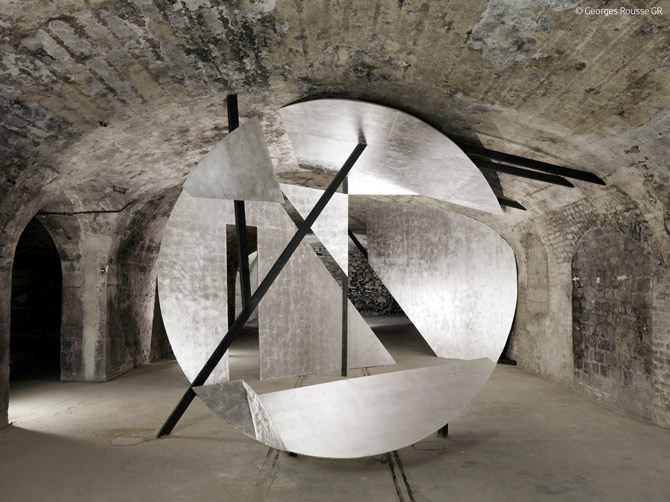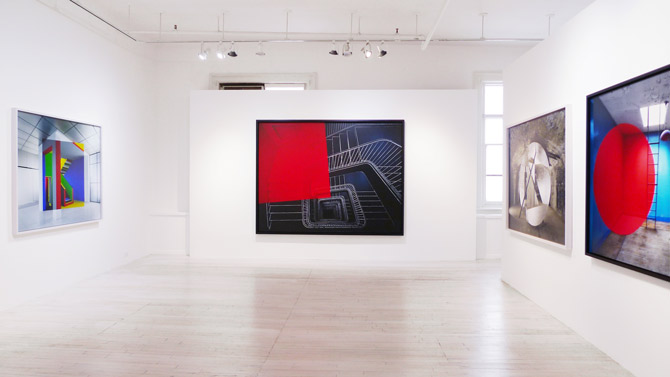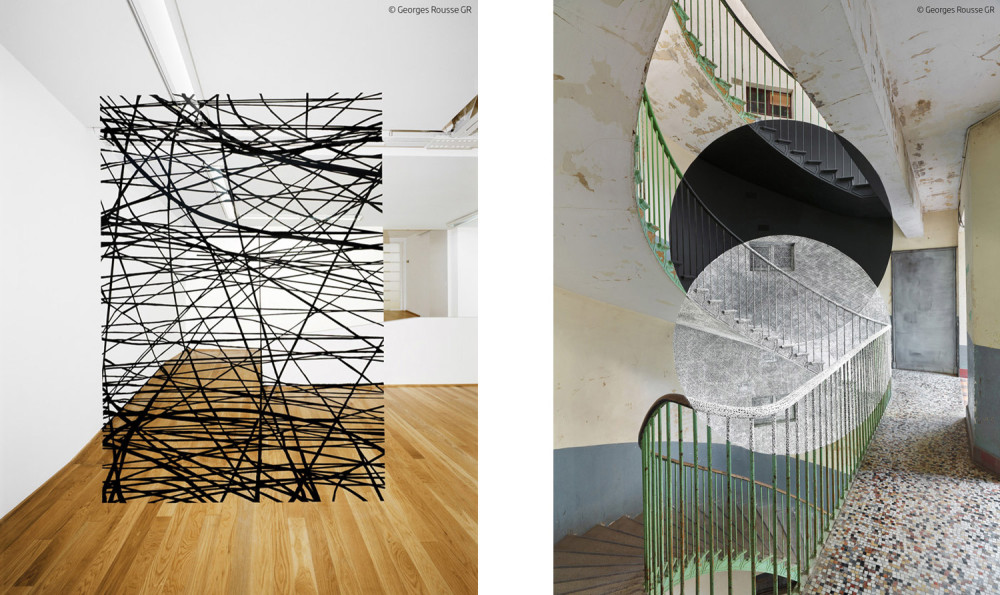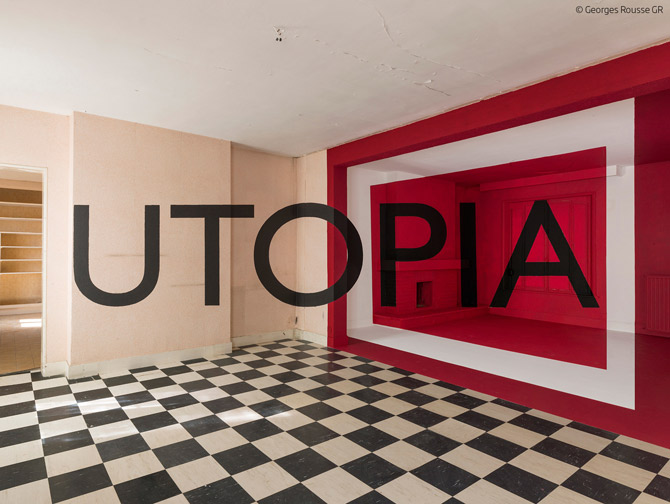Image above: © Georges Rousse, Monferrand, 2012 / Courtesy of Georges Rousse and Sous Les Etoiles Gallery, New York.
Currently on view at Sous Les Etoiles Gallery is Éloge des Lieux (In Praise of Spaces), Georges Rousse’s premiere exhibition featuring work never before exhibited in the US. This exhibition marks the first American solo show for the French artist and photographer in over a decade. It will be on view until November 28th, 2015.
Image above: © Georges Rousse, Reims, 2012 / Courtesy of Georges Rousse and Sous Les Etoiles Gallery, New York.
Using space as his raw material, Rousse converts abandoned locations into almost spiritual visions of color and shape, translating his intuitive, instinctual readings of space into masterful images of several “realities”: that of the actual space, abandoned or soon-to-be demolished; the artist’s imagined mise-en-scène; and the final photograph, or the reality flattened. Here, the physical reality, like the derelict spaces in which the artist’s actual marks are made, is temporary. The final— and only lasting—image is the product of the camera shutter from one and only one vantage point. The resulting optical illusion is no mere trompe-l’oeil, but rather an otherworldly visual—ephemeral and, above all, unforgettable.
Image above: Exhibition currently on view at Sous Les Etioles Gallery / Courtesy of Sous Les Etoiles Gallery, New York.
Musée Magazine's Editor-in-Chief, Andrea Blanch, had the opportunity to interview Rousse about his show and art practice in general:
AB: How does it feel to be back in the US exhibiting work for your solo show? What took you so long to come back?
GR: After my last project in Durham, North Carolina in 2006, where I worked for over a month in the spaces left by the tobacco industry, I had many projects elsewhere in the world— Asia, Europe, South America. With no gallery in the US, I have not had much exposure between Durham and now, being represented by Sous Les Etoiles Gallery in New York.
I am of course very happy to continue to show my work in the US and undertake some new projects.
AB: Would you describe your process of creating these striking and unusual images from start to finish? And how did you arrive at this process?
GR: First, in my work process, there is the identification, and then recognition of a raw and empty building. Most often it's an abandoned place that will be destroyed or transformed, but it can also be a museum space, or a historical monument. Inside, I permeate the place and I select several spaces that seem interesting by the relationship of light to architecture. In my studio, I make a series of watercolors that allow me to realize one or more projects. With the drawing I can better understand the difficulties of space constraints, and the incidence of light on architecture. When I'm ready, I transform the place with the chosen project.
Since childhood I have always loved appropriating empty and abandoned places. First, by only photographing them, and I have always systematically photographed them. With the discovery of Land Art I decided to introduce the paint in these derelict places in order to turn them into works of art. By acting on the place I establish a relationship between painting and the space. Photographing these disappearing places allows me to memorize them, the actual spaces, as well as my intervention.
AB: Following up on that, which comes first, the idea or the space? Meaning, do you find the space first and then come up with the idea, or do you have an idea and then seek out the space that fits best?
GR: There is first the place that I find or which someone suggests to me, but within those places I choose one or several areas where I will intervene. Some indications, or specific details, suggested by the configuration of the place, its location, and its environment, appear to me once I am onsite. I translate the knowledge of the space through drawing. At this time several ideas can be born that evolve before being realized.
I usually like to first have physical contact with the space in which I will realize the first project. That allows me "to inhabit the space," confirm my initial intuitions, and to see how light evolves over time to achieve it. After a few days of occupying the space, other areas appear to me with other opportunities that can be used for another installation at this location or elsewhere. I then make a catalog of projects which, now or later, will be completed.
Images above: Left - © Georges Rousse, Barcelone, 2003, Right - © Georges Rousse, Guise, 2015 / Courtesy of Georges Rousse and Sous Les Etoiles Gallery, New York.
AB: Why do you choose derelict spaces for your art pieces? Is this about the impermanence of art itself, etc.?
GR: Buddhism was already teaching the impermanence of man and therefore of Art.
I always liked these lonely places, out of time, suspended between life and death. By re-enchanting the dead, rejected, and ignored spaces, that are like images of human destiny, I make chaos readable, liberating the beauty within the ruin. That's why I use photography—to memorize my actions in abandoned places. I always thought that these places could be regarded as artists' studios; being empty, they could be mine during the time of my intervention, an atelier where a poetic state is organized, nurtured by the present traces and remains that I find there.
Often these places are in popular neighborhoods, isolated by fences. For me, they activate the poetry of my loneliness when in contact with man. Rumors of the city rise up to me and develop into a kind of make-believe, a bit like the shadows that question the philosopher in Plato's cave.
AB: Your work merges painting, architecture, and photography. What works have influenced this exhibition?
GR: Land Art showed that photography could translate an action in landscape. I applied this principle to the abandoned places that I transformed. As the Land Art artists, I create a specific and ephemeral installation in the real—in the architectural spaces—but while photography had for the Land Art artists a function of transcription and documentation of the work performed in the landscape, it is to me the purpose of an artistic action; it is the artwork.
I have always believed in the power of photography when the pioneers of photography showed the photograph inside the pyramids or when they discovered the wilderness. The current exhibition at Sous Les Etoiles Gallery shows different works, each with its own history of the place itself, its location, the city, the country, the country's culture. The basics of my work can be found in the history of art and painting, especially in Italy, where the church is at once sacred space, sacred painting, perspective, and architecture.
AB: What artists have influenced your career? Are there any younger artists that you find inspiring now?
GR: American painters have fed my work with color, the notion of space, but also the Renaissance painting at the time of the discovery of perspective. The painter Malevich, for the simplification of forms. K. Schwitters, with the invention of Merzbau. This work disappeared after the last war, surviving only due to the photographs he had made. But also Brancusi, the sculptor, who photographed his works. And the artists of the Land Art movement.
AB: Why make these optical illusions physically rather than digitally?
GR: This is a question that we can ask today, but when I realized my first works in the early 80s, there was no Photoshop. People understood immediately that it was a work in a real space.
I transform spaces that will disappear. Before this disappearance, often violent at the time of their destruction, I intervene so as to give them a final status, the status of artwork, as a revival. For example, I worked in former slaughterhouses that have subsequently become a museum. The creation of an artwork is for me like for those who work with me on a project: a metaphysical experience, an immersion in space, color, light, in the total emptiness of the deserted spaces, fit for meditation.
I do not do optical illusions. Everything is organized from my camera. As I transform a three-dimensional space into the final, flat, two-dimensional image, I use the fixed point of view of my camera, and thus I draw in space an anamorphosis linked to photography as an optical process.
AB: Do you identify yourself as a photographer?
GR: Organizing my space as an architectural photographer, using mostly natural light and taking my photographs myself, I feel like a photographer. But things are not so simple, because in the space I am the painter who will also undertake a kind of fresco. This is a bodily relationship that I seek to produce through the monumental photograph that I show.
I have undertook many works as an architect or sculptor to transform the architecture of the place by cutting or building volumes in space. My identification is complex since it concerns different arts. I identify best perhaps with this Total Art that was the ambition of Kurt Schwitters.
AB: Your work has received international acclaim. How does that feel? Has it affected your work and how do you see your work evolving from here?
GR: I'm still fascinated by abandoned spaces and I continue to photograph them, as if I would work there. International recognition has not changed my relationship to art but as I get more and more proposals, I can discover other cultures, other unlikely places, other perceptions of space.
For several years, I created installations with underserved teenagers because I believe in the power art has on the mind and on education. So I made an installation with young French and Indian people in an immense slum of Mumbai, about 600,000 people, in order to initiate a kind of art education.
My work always evolves. I make my various basic actions on architecture, but it is by being there that other possibilities arise which feed my artistic evolution.







